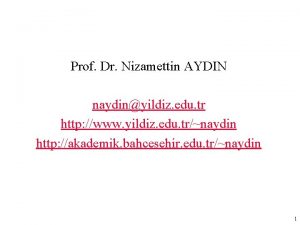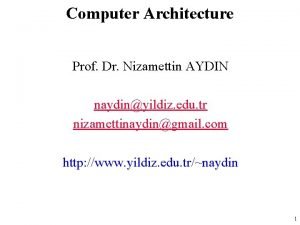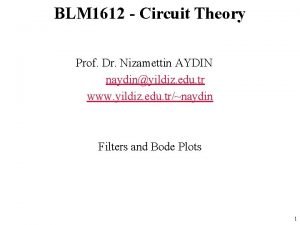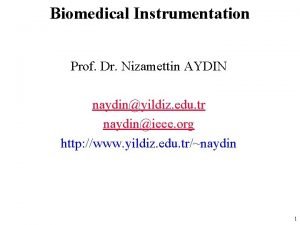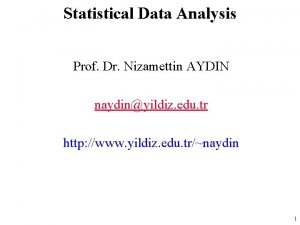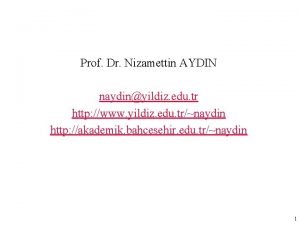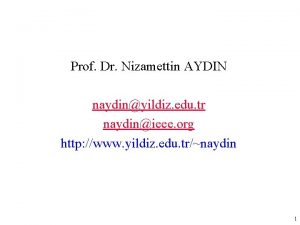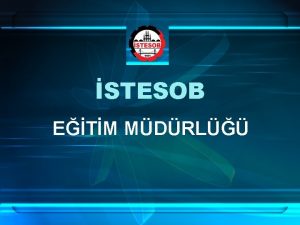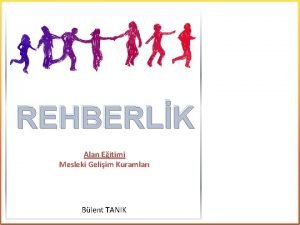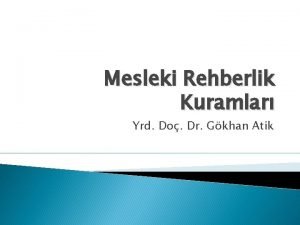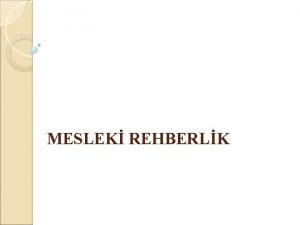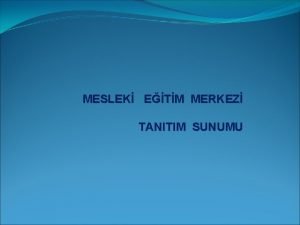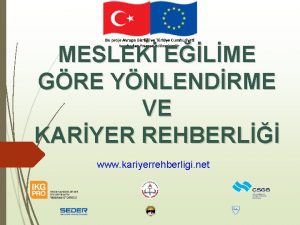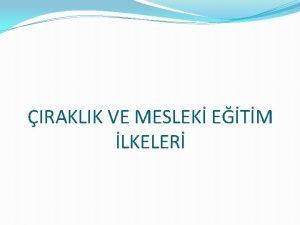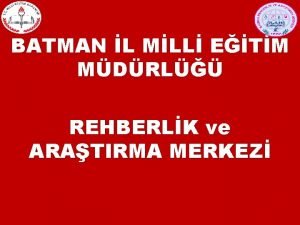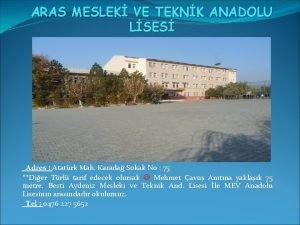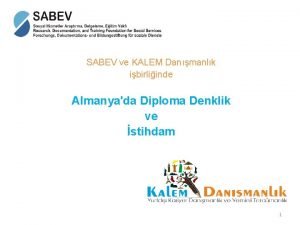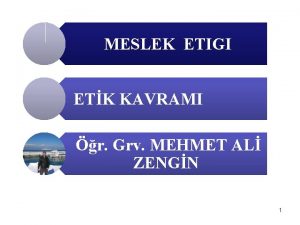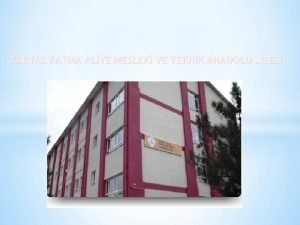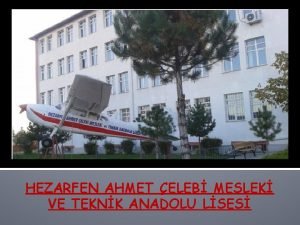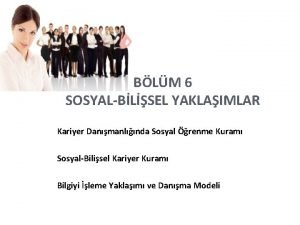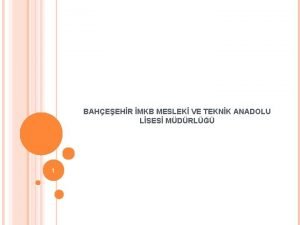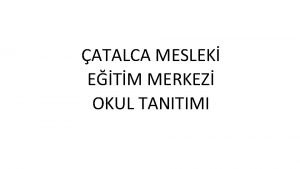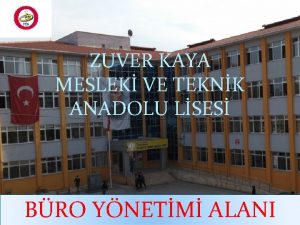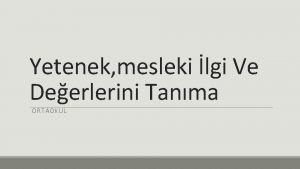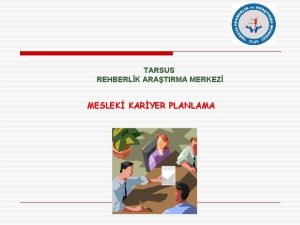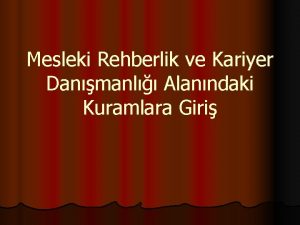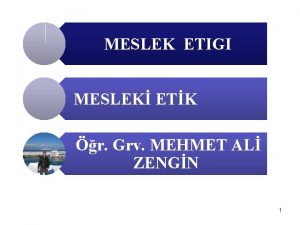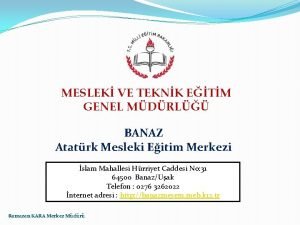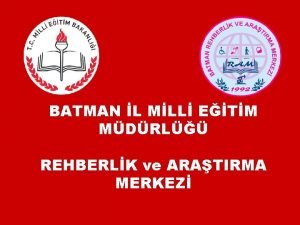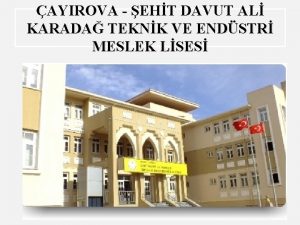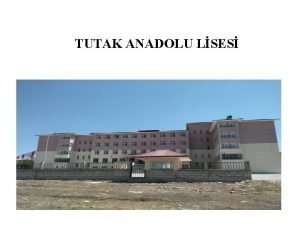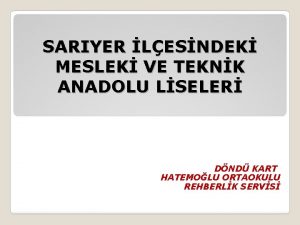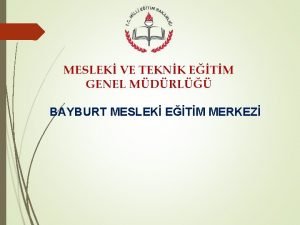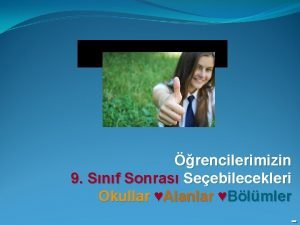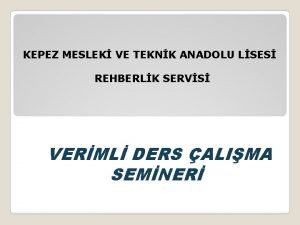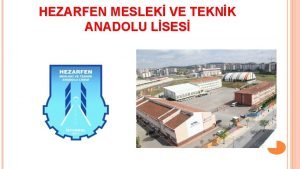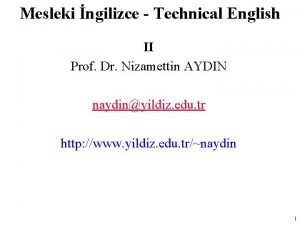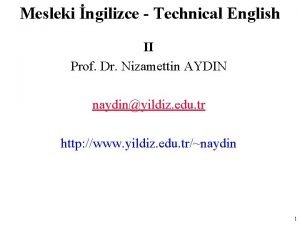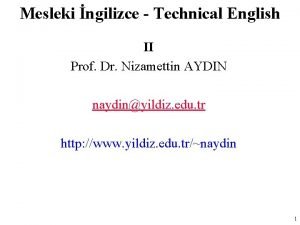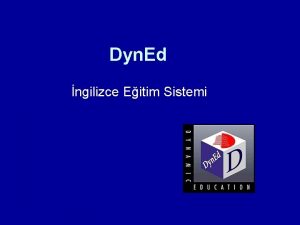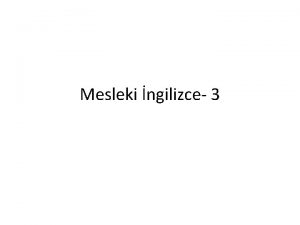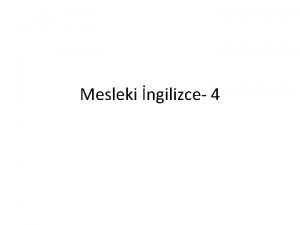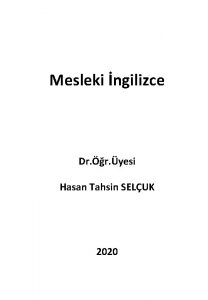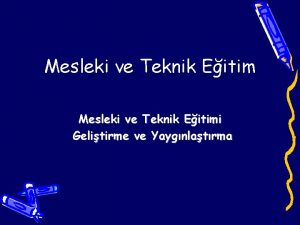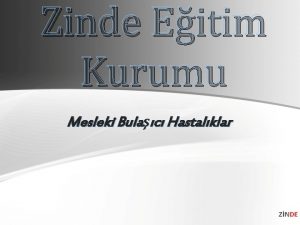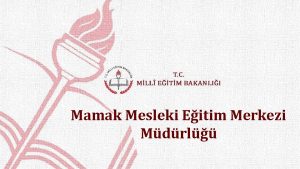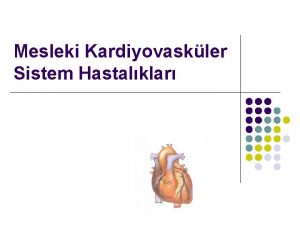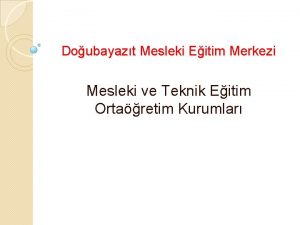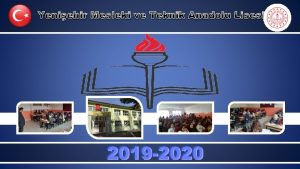Mesleki ngilizce Technical English II Prof Dr Nizamettin

























































- Slides: 57

Mesleki İngilizce - Technical English II Prof. Dr. Nizamettin AYDIN naydin@yildiz. edu. tr http: //www. yildiz. edu. tr/~naydin 1

• Notes: – In the slides, • texts enclosed by curly parenthesis, {…}, are examples. • texts enclosed by square parenthesis, […], are explanations related to examples. 2

Processing Complex Quadrature Signals • Learning Objectives – to understand inter disciplinary nature of biomedical signal processing – to become familiar with ultrasound applications – to understanding, the limits, capabilities, and benefits of digital signal processing • Sub areas covered – – mathematics electronics transform domain processing algorithms 3

Processing Complex Quadrature Signals • Keywords – Complex signals • a two dimensional signal whose value at some instant in time can be specified as a single complex number having two parts: real part and imaginary part – Quadrature Signals • signals that based on the notion of complex numbers • used in many digital signal processing applications • same as the complex signals – Doppler effect/shift • The Doppler effect (or the Doppler shift) is the change in frequency or wavelength of a wave for an observer who is moving relative to the wave source 4

Processing Complex Quadrature Signals • Keywords – ultrasound • sound at frequencies greater than 20 k. Hz – demodulator • an electronic circuit (or computer program in a software defined radio) that is used to recover the information content from the modulated carrier wave – time–frequency analysis • time–frequency analysis comprises those techniques that study a signal in both the time and frequency domains simultaneously, using various time–frequency representations. 5

Processing Complex Quadrature Signals • Keywords – Fourier transform • The Fourier transform (FT) decomposes a function of time (a signal) into the frequencies that make it up, in a way similar to how a musical chord can be expressed as the frequencies (or pitches) of its constituent notes – sonogram • a graph representing a sound, showing the distribution of energy at different frequencies • a visual image produced from an ultrasound examination – wavelet • A wavelet is a mathematical function used to divide a given function or continuous time signal into different scale components. Usually one can assign a frequency range to each scale component 6

Processing Complex Quadrature Signals • Reading text • Pre reading questions –? 7

Physics and Principles of Ultrasound • Ultrasound has a storied history which achieved reality during World War II in finding German submarines in the protection of North Atlantic convoys. • It was initially employed for its therapeutic benefits in physical therapy to produce deep heat and ablation of brain lesions for Parkinson’s disease. • The wave characteristics have been altered in diagnostic ultrasound to the point where energy transfer is limited, and deep tissue heat is virtually nonexistent. 8

Physics and Principles of Ultrasound • Ultrasound systems are comprised of a transducer, console (which contains the computer software, electrical components, Doppler technology, and storage), and the display. • The physics of ultrasound waves and the means of their delivery are important to meld into this discussion. • Some of the creatures use sound waves in a remarkable way. • Sound waves depend on a support transport medium 9

Physics and Principles of Ultrasound • Dolphins and odontocetes such as toothed whales emit very high pitched single frequency clicks to communicate with others of their species • It is also used for echo localization of schools of fish upon which they prey. • Baleen whales which feed on plankton do not transmit in the high frequency range but more on the order of 10– 30 Hz. – These sound waves travel extreme distances due to both their low frequency and the medium of transport which has important communication advantages. 10

Physics and Principles of Ultrasound • The principles of ultrasound are complex, relying on sophisticated physics and mathematics. • Sound is transmitted as sequential sine waves whose height represents amplitude or loudness 11

Physics and Principles of Ultrasound • The human ear can recognize sounds as low as 20 Hz and as high as 20, 000 Hz, and ultrasound is so named because its frequency emission is in the range of more than a million cycles per second or in the megahertz range. 12

Physics and Principles of Ultrasound • An ultrasound wave is transmitted to human tissues through the transducer by physical deformation of the tissue surface. • This is accomplished through piezoelectric crystals which elongate and shorten in response to applied alternating electrical current 13

Physics and Principles of Ultrasound • Elephants also transmit in this approximate low frequency range with a volume level which may reach 117 d. B. • These transmissions can be identified as far as 10 km from the source and may also be sensed by the broad elephant’s feet or the trunk which it may place along the ground to “hear” in this unique way. • Bats emit sounds in the ultrasound range to identify insects and obstructions – but the waves are disadvantaged by having to travel in air 14

Doppler • Japanese scientist Satomura in 1956 observed that erythrocytes can reflect ultrasonic waves and this effect is called the Doppler effect. • Doppler effect is a change in frequency of the reflected ultrasound waves backscattered from the structure that is in motion. 15

Doppler ultrasound Doppler tutorial • As an object emitting sound moves at a velocity v, • the wavelength of the sound in the forward direction is compressed (λs) and • the wavelength of the sound in the receding direction is elongated (λl). • Since frequency (f) is inversely related to wavelength, the compression increases the perceived frequency and the elongation decreases the perceived frequency. • c = sound speed. 16

Doppler ultrasound ft is transmitted frequency fr is received frequency v is the velocity of the target, θ is the angle between the ultrasound beam and the direction of the target's motion, and c is the velocity of sound in the medium 17

A general Doppler ultrasound signal measurement system 18

Processing of Doppler Ultrasound Signals Gated transmiter sin Master cos osc. Demodulator Sample & hold Band-pass filter si Demodulator Sample & hold Band-pass filter sq Further processing Logic unit Receiver amplifier RF filter Transducer V • • • Demodulation Quadrature to directional signal conversion Time frequency/scale analysis Data visualization Detection and estimation Derivation of diagnostic information 19

Quadrature phase detection 20

Quadrature Signals • Quadrature signals are based on the notion of complex numbers • used in many digital signal processing applications such as – – – – Communication Radar Sonar Ultrasound MR imaging Direction finding schemes Antenna beamforming applications Single sideband modulators 21

• A quadrature signal is a two dimensional signal whose value at any given time can be specified by a single complex number – Such as a(t)+jb(t) • Quadrature signal processing is used in many fields of science and engineering – Processing of complex quadrature signal provides additional processing power by enabling to measure amplitude and phase of a signal simultaneously 22

General Definition of Quadrature Doppler Signal • A general definition of a discrete quadrature Doppler signal equation can be given by • D(n) and Q(n), each containing information concerning forward channel and reverse channel signals (sf(n) and sr(n) and their Hilbert transforms H[sf(n)] and H[sr(n)]), are real signals. 23

Properties of Complex Quadrature Doppler US signals 24

DSP for Quadrature to Directional Signal Conversion • Time domain methods – Phasing filter technique (PFT) (time domain Hilbert transform) – Weaver receiver technique • Frequency domain methods – Frequency domain Hilbert transform – Complex FFT – Spectral translocation • Scale domain methods – Complex continuous wavelet – Complex discrete wavelets 25

Hilbert Transform. . . • The Hilbert transform (HT) is a widely used frequency domain transform. • It shifts the phase of positive frequency components by -900 and negative frequency components by +900. • The HT of a given function x(t) is defined by the convolution between this function and the impulse response of the HT (1/πt). 26

. . . Hilbert Transform • Specifically, if X(f) is the Fourier transform of x(t), its Hilbert transform is represented by XH(f), where • A ± 900 phase shift is equivalent to multiplying by ej 90 0 =±j, so the transfer function of the HT HH(f) can be written as 27

Impulse Response of HT An ideal HT filter can be approximated using standard filter design techniques. If a FIR filter is to be used , only a finite number of samples of the impulse response suggested in the figure would be utilised. 28

Complex Modulation 29

• x(t)ejωt is not a real time function and cannot occur as a communication signal. • However, signals of the form x(t)cos(ωt+θ) are common and the related modulation theorem can be given as • So, multiplying a band limited signal by a sinusoidal signal translates its spectrum up and down in frequency by ωc 30

Asymmetrical implementation of the PFT Doppler signal equation: Mathematical description of algoritm: 31

Symmetrical implementation of the PFT 32

Simulation result 33

• • • An alternative algorithm is to implement the HT using phase splitting networks A phase splitter is an all pass filter which produces a quadrature signal pair from a single input The main advantage of this algorithm over the single filter HT is that the two filters have almost identical pass band ripple characteristics 34

Weaver Receiver Technique (WRT) • For a theoretical description of the system consider the quadrature Doppler signal defined by which is band limited to fs/4, and a pair of quadrature pilot frequency signals given by where ωc/2π=fs/4. • The LPF is assumed to be an ideal LPF having a cut off frequency of fs/4. 35

Asymmetrical implementation of the WRT 36

37

38

Graphical description 39

Symmetrical implementation 40

Simulation result 41

FREQUENCY DOMAIN PROCESSING • These algorithms are almost entirely implemented in the frequency domain (after fast Fourier transform), • They are based on the complex FFT process. • The common steps for the all these implementations: – the complex FFT, – the inverse FFT – overlapping techniques to avoid Gibbs phenomena • Three types of frequency domain algorithm will be described: Hilbert transform method, Complex FFT method, and Spectral translocation method. 42

FT of Complex Functions • If x(t) is a complex time function, i. e. x(t)=xr(t)+jxi(t) where xr(t) and xi(t) are respectively the real part and imaginary part of the complex function x(t), • then the Fourier integral becomes 43

Properties of the Fourier transform for complex time functions Time domain (x(t)) Frequency domain (X(f)) Real part even, imaginary part odd Imaginary Real part odd, imaginary part even Real even, imaginary odd Real odd, imaginary even Imaginary Real and even Real and odd Imaginary and even Imaginary and odd Real and odd Complex and even Complex and odd 44

Interpretation of the complex Fourier transform • If input of the complex Fourier transform is a complex quadrature time signal (specifically, a quadrature Doppler signal), it is possible to extract directional information by looking at its spectrum. • Next, some results are obtained by calculating the complex Fourier transform for several combinations of the real and imaginary parts of the time signal (single frequency sine and cosine for simplicity). • These results were confirmed by implementing simulations. 45

• Case (1). • Case (2). • Case (3). • Case (4). • Case (5). • Case (6). • Case (7). • Case (8). 46

Frequency domain Hilbert transform algorithm 47

Complex FFT Method (CFFT) • The complex FFT has been used to separate the directional signal information from quadrature signals – so that the spectra of the directional signals can be estimated and displayed as sonograms. • It can be shown that the phase information of the directional signals is well preserved and can be used to recover these signals. 48

49

50

Spectral Translocation Method (STM) 51

52

r r Real output Inverse FFT Imaginaryoutput 53

54

• The averaged output power spectra of the simulations for; – (a) the reference quadrature signal, – (b) the PFT, – (c) the EWRT, – (d) the HTM, – (e) the CFFT and – (f) the STM. • Magnitude scale is 7. 7 d. B/Div. 55

• Results for time domain separation techniques. Logarithmic scale output spectra of practical implementations for; – – – (a) PFT; (b) EWRT; (c) HTM; (d) complex FFT; (e) STM • when the input is a narrow band quadrature signal containing the forward and reverse flow components (magnitude scale is 8. 8 d. B/Div). 56

57
 Prof. dr. nizamettin aydin
Prof. dr. nizamettin aydin Prof. dr. nizamettin aydin
Prof. dr. nizamettin aydin Prof. dr. nizamettin aydin
Prof. dr. nizamettin aydin Prof. dr. nizamettin aydin
Prof. dr. nizamettin aydin Ngilizce
Ngilizce Nizamettin aydin
Nizamettin aydin Nizamettin aydin
Nizamettin aydin Kilo mega giga tera peta
Kilo mega giga tera peta Asd-ste 100
Asd-ste 100 Technical communication
Technical communication Ulusal meslek bilgi sistemi
Ulusal meslek bilgi sistemi Almanya eğitim sistemi şeması
Almanya eğitim sistemi şeması Mesleki gelişim kuramları
Mesleki gelişim kuramları Rehberlik kuramlar
Rehberlik kuramlar Deontoloj
Deontoloj Mesleki cilt hastalıkları
Mesleki cilt hastalıkları Mesleki yozlaşmanın nedenleri
Mesleki yozlaşmanın nedenleri Kariyer yaşam çizgisi
Kariyer yaşam çizgisi Superin benlik kuramı
Superin benlik kuramı Mesleki eğitim merkezi tanıtım
Mesleki eğitim merkezi tanıtım Kariyerrehberliği.net maybe testi
Kariyerrehberliği.net maybe testi Osman düşüngel mesleki eğitim merkezi
Osman düşüngel mesleki eğitim merkezi Hezarfen mesleki ve teknik anadolu lisesi
Hezarfen mesleki ve teknik anadolu lisesi Batman piri reis mesleki ve teknik anadolu lisesi
Batman piri reis mesleki ve teknik anadolu lisesi Aras mesleki ve teknik anadolu lisesi
Aras mesleki ve teknik anadolu lisesi Mbs ulusal mesleki bilgi sistemi
Mbs ulusal mesleki bilgi sistemi Almanyada denklik
Almanyada denklik Necatibey mesleki ve teknik anadolu lisesi
Necatibey mesleki ve teknik anadolu lisesi Super yaşam boyu yaşam alanı
Super yaşam boyu yaşam alanı Kendi evinizde iken ailenize
Kendi evinizde iken ailenize Kartal fatma aliye mesleki ve teknik anadolu lisesi
Kartal fatma aliye mesleki ve teknik anadolu lisesi Rehberlik mesleki yeterlilik
Rehberlik mesleki yeterlilik Mesleki q gram
Mesleki q gram Hezârfen ahmed çelebi meslek
Hezârfen ahmed çelebi meslek Hacı halit erkut mesleki ve teknik anadolu lisesi
Hacı halit erkut mesleki ve teknik anadolu lisesi Buca mevlana mesleki ve teknik anadolu lisesi
Buca mevlana mesleki ve teknik anadolu lisesi Iasdu döngüsü
Iasdu döngüsü Bahçeşehir imkb mesleki ve teknik anadolu lisesi
Bahçeşehir imkb mesleki ve teknik anadolu lisesi Gevher nesibe mesleki ve teknik anadolu lisesi bölümleri
Gevher nesibe mesleki ve teknik anadolu lisesi bölümleri çatalca mesleki eğitim merkezi
çatalca mesleki eğitim merkezi Zuver kaya mesleki ve teknik anadolu lisesi
Zuver kaya mesleki ve teknik anadolu lisesi Yetenekler mesleki ilgi ve değerlerini tanıma
Yetenekler mesleki ilgi ve değerlerini tanıma Mesleki kariyer
Mesleki kariyer Kendini keşfetme ölçeği
Kendini keşfetme ölçeği Iş hayatında etik dışı davranışlar
Iş hayatında etik dışı davranışlar Mesleki eğitim merkezi meslek dalları 2021
Mesleki eğitim merkezi meslek dalları 2021 Batman ibni sina mesleki ve teknik anadolu lisesi
Batman ibni sina mesleki ve teknik anadolu lisesi Eht grafik
Eht grafik Islam uyar mesleki ve teknik anadolu lisesi bölümleri
Islam uyar mesleki ve teknik anadolu lisesi bölümleri Ulusal mesleki bilgi sistemi
Ulusal mesleki bilgi sistemi Tutak mesleki ve teknik anadolu lisesi
Tutak mesleki ve teknik anadolu lisesi Mehmet rıfat evyap mesleki ve teknik anadolu lisesi
Mehmet rıfat evyap mesleki ve teknik anadolu lisesi Bayburt mesleki eğitim merkezi
Bayburt mesleki eğitim merkezi Mesleki cilt hastalığına neden olan fiziksel faktörler
Mesleki cilt hastalığına neden olan fiziksel faktörler Zehra emine öçgüder mesleki ve teknik anadolu lisesi
Zehra emine öçgüder mesleki ve teknik anadolu lisesi Kepez mesleki ve teknik anadolu lisesi
Kepez mesleki ve teknik anadolu lisesi Hezarfen mesleki ve teknik anadolu lisesi bölümleri
Hezarfen mesleki ve teknik anadolu lisesi bölümleri Halide gencer mesleki ve teknik anadolu lisesi
Halide gencer mesleki ve teknik anadolu lisesi
